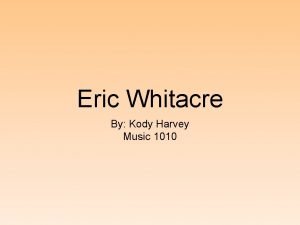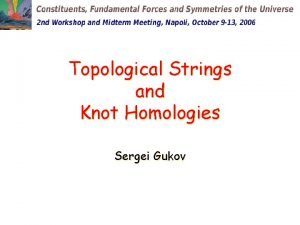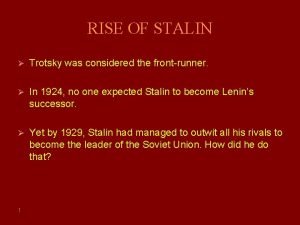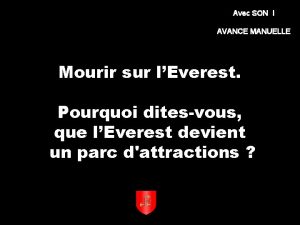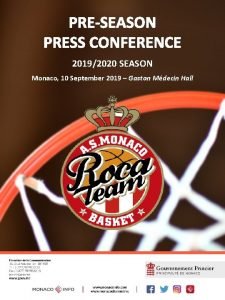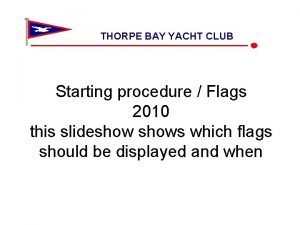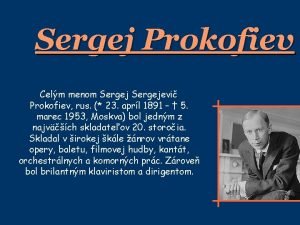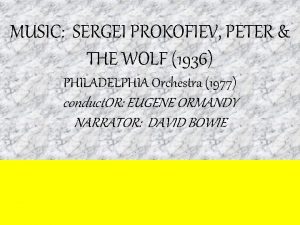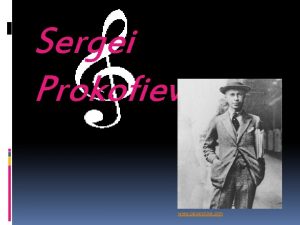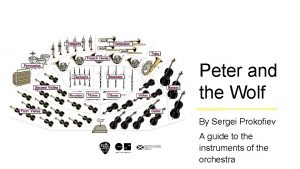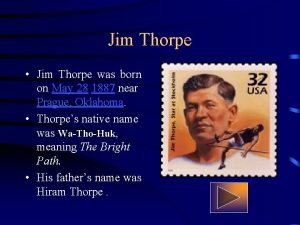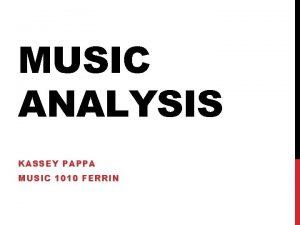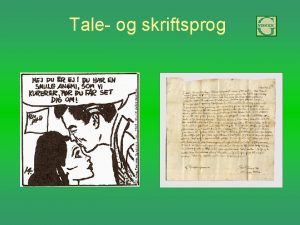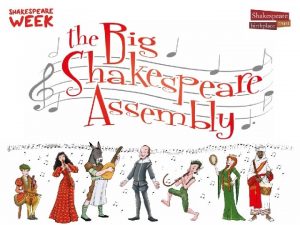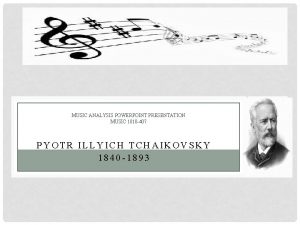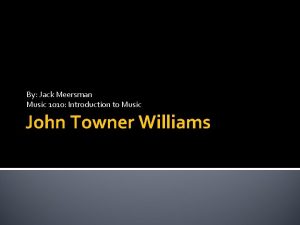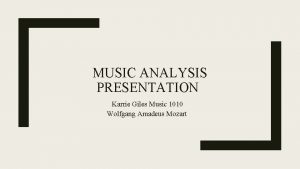Sergei Prokofiev Sean Thorpe Music 1010 A Tale



















- Slides: 19

Sergei Prokofiev Sean Thorpe Music 1010

A Tale of a Real Man Born 1891 in Sontsovka, Ukraine Russian composer known for concertos, operas, symphonies, film music, ballet scores, and his famous work for children, Peter and the Wolf

A Tale of a Real Man As a child, his inspiration for music came from his mother as he would listen to her play compositions from Beethoven and Chopin. He wrote his first opera at the age of 8 after seeing the Sleeping Beauty. Titled “The Giant” He called his early compositions “Puppies” As a child he would avoid the black keys because he was afraid of them. He even play “white” music as an adult, avoid the black keys

A Tale of a Real Man His music was just as unpopular as he was, him being a very blunt and somewhat rude person Critics were so harsh on his music that one once wrote a review on a piece that was never performed His music was described as “violent” and “barbaric” “A Tale of a Real Man” was banned by Stalin for political reasons His first concerto was nicknamed “hit on the head” because the first four notes sound so powerful

A Tale of a Real Man When people walked out on his music, he would blame them not his music He never gave up! When it was first composed, much of his music was so controversial that conductors of his symphonies sometimes received death threats Today he is one of the most frequently performed modern composers Peter and the Wolf, one of his most famous pieces, introduces children to classical music around the world today

A Tale of a Real Man Married twice, once to a Lina Llubera, a Spanish singer with whom he had two sons. Then to Myra Mendelson, a Russian writer He always dressed nicely, wearing a coat and tie to breakfast He would walk for miles to get cigarettes He was an advent pet owner with a wolf like dog named Mendoza, and a cat who slept on his arm chair

A Tale of a Real Man Chess was his favorite thing next to music He also loved to read biographies He would also write in his diary every day even in the bathroom. He would keep his reviews and note in his diary

Compositional History Piano Concerto No. 1 in D-flat Major Op. 10

Piano Concerto No. 1 in D-flat Major Op. 10 Has three listening sections Allegro Brioso Andante Assai Allegro Scherzando

Piano Concerto No. 1 in D-flat Major Op. 10 Started writing it in 1911 and finished in 1912 It is the shortest of all five of his concertos running only 15 minutes First performed in Moscow Won the Anton Rubinstein Prize

Compositional History Peter and The wolf

Peter and The wolf Peter and the Wolf is a musical fairy tale for children It tells the story of a young boy who captures a wolf Written in 1936 by invitation for a children's symphony Was unpopular at first

Peter and The wolf In this fairy tale, each character is represented by a different instrument The grandfather by the bassoon Peter by the violins and the string section The bird by the flute The duck by the oboe The cat by the clarinet The wolf by the French horns The hunter by the kettledrums and the big bass drums

Peter and The wolf Peter and the wolf has been and will be, introducing children to classical music for a very long time

Listening Journal Eine Kleine Nachtmusik 4 th Movement This string orchestra piece gives the perfect background noise while waiting to be seated for a play. With the music in a major it gives the music a fun feel to it. With the tempo being allegro it makes the music and people keep going while still keeping the peace with the mezzo piano dynamic. This piece is simple and it in the regular phrases with eight measures. I personally enjoy this composition. It is a nice calming piece that can be played for entertainment or merely as background noise. This piece reminds me of naptime, which could be why I enjoy it so thoroughly, who doesn’t love naps?

Listening Journal Toccata and Fugue This concerto is strong with a forte dynamic. The organ makes the perfect instrumentation in this piece, starting out pretty moderate in tempo and then quickly speeding up to an allegro speed. With it being played in a D Minor, it gives theme a more eerie and spooks feel to it. My personal opinion on the piece is very simply put, awesome! This is always one of the all time favorites especially around Halloween time. Bach’s Toccata and Fugue brings back many memories of homemade spook alleys, and frightful nights. I believe that this piece is one of my favorites because of the memories that come with it.

Listening Journal 5 th Symphony: First Movement With combining the fast paced allegro with the second piece of a largo paced piece, Beethoven’s 5 th symphony is in an ABA style. The full orchestra instrumentation gives it a polyphonic texture with multiple strings of music being played together to make beautiful music. In all honesty, every time I hear this song I think of trouble. With movie references that use this song to emphasize the antagonist, it has gotten that connotation in my mind. I still enjoy this piece of classical music, but it is not my favorite.

Listening Journal Rite of Spring: Sacrificial Dance In this ballet style composition, it is clear the tempo is allegro. The short phased melody made it very staccato and cut. It was a mixed dynamic between moderato and forte but leaning more toward forte. I was not the biggest fan of this piece because of the staccato expression. I found it annoying and it gave me a headache. In the end, it did what it was supposed to, which was to express how a sacrificial ceremony would feel like through music which they did splendidly.

Listening Journal Lincoln Portrait The form of this composition was defiantly a tone poem, describing the kind of man that President Lincoln was. It had a largo tempo giving it a feeling of comfort. Dynamically it was a mix between moderato and piano, contributing to the stillness of the piece. This piece was mostly brass with some drums included. It was a Homophonic piece making it very simple. In my opinion, this piece was boring. Although Abe Lincoln was an amazing man, this piece did little to keep my attention. The calming music in the background made me want to fall asleep while listening to the description of the president and his accomplishments. All around it was a boring piece.
 Nasser and prokofiev rockefeller
Nasser and prokofiev rockefeller Online music portfolio
Online music portfolio Eric whitacre bio
Eric whitacre bio Sergei gepshtein
Sergei gepshtein July 1969
July 1969 Sergei naryškin
Sergei naryškin What of this goldfish would you wish theme about happiness
What of this goldfish would you wish theme about happiness Sergei nagaitsev
Sergei nagaitsev Sergei gukov
Sergei gukov Sergei sedov
Sergei sedov Francys arsentiev sergei arsentiev
Francys arsentiev sergei arsentiev Sergei komarov contact info
Sergei komarov contact info Sergueï dyadechko fortune
Sergueï dyadechko fortune Folk character
Folk character Rosenswig mcrae thorpe
Rosenswig mcrae thorpe Gina thorpe
Gina thorpe Thorpe bay yacht club
Thorpe bay yacht club Karla thorpe
Karla thorpe Rfi group
Rfi group Alton towers aims and objectives
Alton towers aims and objectives


